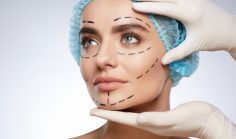And of course, last but certainly not least…
Use Sunscreen!
How does sunscreen work? Sunscreen is made with chemicals that that interact with the skin to protect it from UV rays. Most work by absorbing, reflecting, or scattering sunlight. Since all products don’t use the same ingredients, if you have an allergic reaction to one product, you can try another one, or consult a doctor for a recommendation!
SPF
Sunscreens are rated with a number that indicated their effectiveness against blocking harmful UV rays. The higher the number, the more effective they are. According to the AAD, a sunscreen with SPF 30 (which is their minimum recommendation) blocks 97 percent of the sun’s rays. While higher number SPFs block slightly more of the sun’s rays, it’s important to know that: NO sunscreen can block 100% of the sun’s rays.
High-number SPFs last the same amount of time as low-number SPFs. That’s why all sunscreens should be applied approximately every two hours when outdoors, even on cloudy days, and after swimming or sweating.
Application
Just as a base rule, the CDC recommends applying a broad-spectrum sunscreen before you go outside, even on slightly cloudy or cool days. Many skincare brands offer daily moisturizer with SPF – it’s great to get into the habit of wearing SPF on a daily basis!
When it comes to application, the AAD recommends you:
- Remember, “one ounce—enough to fill a shot glass.” This is about the amount that dermatologists feel is needed to cover the exposed areas of your body. But, it’s important to adjust the amount of sunscreen you apply depending on your body size. Most people only apply 25-50 percent of the recommended amount of sunscreen!
- Generously coat ALL exposed areas of skin
- Apply sunscreen to your dry skin 15 minutes BEFORE you go outside
- Reapply every two hours, or after you go swimming or perspire heavily. It’s a good idea to check the directions on the bottle, but remember…
- Don’t think your sunscreen is “water proof!” Sunscreen manufacturers now are banned from claiming that a sunscreen is “waterproof” or “sweat proof,” as the FDA has determined that those terms are misleading! They can, however, be labeled as “Water Resistant” — up to 40 minutes or 80 minutes. This means that sunscreen provides some protection while swimming or sweating, up to the time listed on the label.
- Don’t forget about your lips. Skin cancer can form on your lips, so make sure to use a lip balm with SPF, or sunscreen made especially for your lips.
Types of Sunscreen
There are many types of sunscreen, from sprays to lotions. It’s really up to a personal preference, which may vary for different parts of your body. The ADD offers some recommendations:
- Creams –best for dry skin and the face.
- Gels – good for hairy area (such as the scalp or male chest).
- Sticks – good to use around the eyes.
- Sprays – sometimes preferred by parents, since they can be easier to apply to children! A spray can also be handy for men to apply to a balding scalp. However, it’s important that you make sure that your are using enough spray sunscreen. The entire surface area of your exposed skin must be covered, thoroughly. Also, make sure you don’t these products, or apply near heat, open flame or while smoking. Also, the AAD says it’s important to note that current FDA regulations on testing and standardization do not pertain to spray sunscreens, though the FDA does continue to evaluate spray sunscreens products to ensure safety and effectiveness.
- There also are sunscreens made for specific purposes, such as for sensitive skin and babies.
- Regardless of which sunscreen you choose, be sure to apply it generously to achieve the UV protection indicated on the product label.
How Long Does Sunscreen Last?
Since the AAD recommends applying sunscreen on a daily basis, a bottle of sunscreen should not last very long. However, you may have different bottle and containers of sunscreens, some of which you use more often than others. If you’ve got an older bottle, follow these guidelines:
- It’s required by the FDA that all sunscreens retain their original strength for at least three years.
- If your bottle of sunscreen has an expiration date, and it has passed, throw it out.
- If you buy a sunscreen that does not have an expiration date, write the date you bought the sunscreen on the bottle, so you’ll know when to throw it out.
- There are also visible signs that a sunscreen may no longer be good., such as any obvious changes in the product’s color or consistency.
The American Academy of Dermatology recommends everyone use sunscreen that offers the following:
- Broad-spectrum protection (protects against UVA and UVB rays).
- Sun Protection Factor (SPF) 30 or greater. (The FDA recommends using at least SPF 15 on a daily basis, but the AAD believes a minimum of SPF 30 is necessary).
- Water resistance.
Physical Sunblock
Physical sunscreen, otherwise known as sunblock, such as zinc oxide, will stop all sunlight from reaching the skin. However, sunblock is very thick and opaque, and will not absorb into your skin. They can be messy and hard to wash off, so are often not a first choice for the average consumer. They can be great though, for children (some come in bright colors, which is fun for kids), people with very sensitive skin, or to protect a scar from discoloring in the sun.
Cosmetics
Many skin-care and beauty products contain some of the same chemicals that are used in sunscreen, but unless they are labeled with an SPF, they don’t provide any protection from the sun. If they are labeled SPF 15 or higher, just keep in mind that the amount of sunscreen required to provide a full coverage and protection is quite a lot. If you are not using the full amount required to provide adequate protection, don’t use cosmetics with SPF as your only source of protection.











